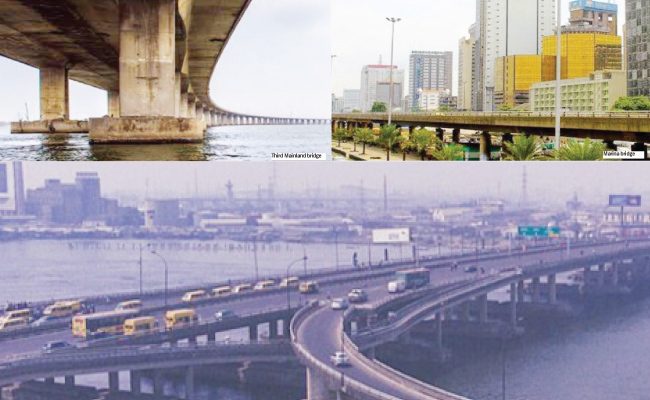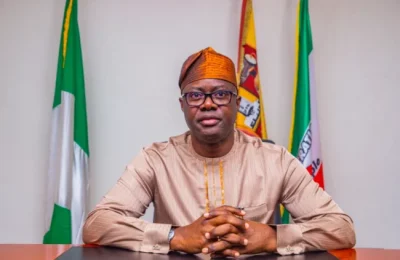Risks posed by chlorination and carbonisation damage to the sub-structures of the Third Mainland, Carter and Marina bridges in Lagos are dominating public discussion with both the minister of Works and National Assembly members calling for a declaration of state of emergency on all Nigeria’s bridges. DAYO AYEYEMI reports.
Built over four decades ago, Carter Bridge, Third Mainland Bridge and Eko Bridge are major three bridges connecting Lagos Island to the mainland.
Currently, revelations by the Minister of Work, David Umahi, concerning the dilapidating conditions of these bridges due to poor maintenance culture are generating concerns.

Despite the rehabilitation of the Third Mainland Bridge recently, discoveries about its sub-structure underwater and that of Carter and Marina bridges are alarming.
For this reason, the Minister of Works, David Umahi, has directed the Federal Ministry of Works’ design Department to immediately launch a project to assess the structural integrity of all the bridges in Lagos and across Nigeria amid concerns over their deteriorating conditions.
Umahi, in company of the National Assembly members, expressed disappointment at the extent of damage from carbonisation and chlorination affecting the pile caps of these bridges.
He explained that each pile cap must be isolated from water and reinforced to prevent further chlorination, a process where chloride absorption compromises the reinforcing rods within the concrete.

“Chlorination involves chloride water absorption by the pile cap, which attacks the reinforcing rods. If not addressed urgently, the internal reinforcement will corrode, risking pile cap failure.
“Further assessments revealed that some piles had detached from their caps or lost contact with the underlying sand, essential for stability through skin friction. Over time, underwater currents, scouring, and illegal sand mining have exacerbated these issues.”
“As we were coming, we saw also a very terrible situation like that of Third Mainland Bridge on the Marina Bridge. So, I will be directing the Ministry of Work’s design department to immediately procure a project to understudy all the bridges in Lagos. Let us see what is happening even on deck and then the superstructures. Phase two will be to understudy what is going on within the piles but we can see that the Marina Bridge is also as bad as what we inherited in Third Mainland Bridge,” he added.
Umahi underscored the importance of this project, noting President Bola Ahmed Tinubu’s commitment to tackling the longstanding structural problems despite public expectations for immediate solutions.
“Some bridges have not been maintained for 53 to 60 years. The government is working, though this may not always be visible,” he added.
Umahi mentioned that a report outlining the risks posed by chlorination and carbonisation damage, along with proposals for large-scale repair work, will be submitted to President Tinubu.
He said, ”So we will be putting out this report to Mr. President on the dangers of not attending to the infrastructure that is damaged through chlorination and carbonization, and then to do massive infrastructural work to arrest the problems affecting the pile caps. This is very important.
“Already, there were inspections done in 2013, 2019 and they saw the worse geometric deterioration of these infrastructures below the water.”
“So we have also commissioned Julius Berger to do their own investigation. Besides that, we have also commissioned another independent consultant to also check the water. So with these four documents, each will give us designs and solutions so that we would be able to take a decision.”
“Since the National Assembly has keyed in fully and has declared state of emergency on our bridges, we are very much sure that we would find solutions to them and arrest them,” he said.
The minister highlighted Lagos’ unique role in Nigeria’s economy, pointing out that the state contributes substantial Value Added Tax and withholding tax revenue.
“A bridge collapse could severely impact these contributions to the federation account, which is why we must prioritise this infrastructure as critical beyond just an investment in Lagos,” he said.
The minister commended Julius Berger for its ongoing assessments and confirmed that the company would further investigate the foundations of these bridges.
The minister and the National Assembly members said it was time to declare state of emergency on Nigeria’s bridges.
He emphasised that the repair of all defective bridges across the country could cost about N341 billion, calling for the support of National Assembly on the estimated funds.
Umahi told the legislators led by the Chairman of the Senate Committee on Works, Senator Mpigi Barinada and his counterpart in the House of Representatives, Mr Akin Alabi “If you want to call for a conference on our bridges, we are willing to answer you. We have proposed that N341 billion will be needed in 2025 to attend to our bridges. We don’t know how much this is going to cost. If we are to rebuild this Cater bridge and the Third mainland bridge, even N30 trillion will not do it. So, a stitch in time saves nine. This is very important.”
According to the minister, the essence of the presentation and inspection tour was to bring to the knowledge of the lawmakers, the extent of damages done to the bridges as a result of dredging activities, chlorination, deflection, carbonation, and marine attacks.
The minister added that it costs Julius Berger N500 million for research to identify the defections.
Pledging their support, members of the National Assembly led by Barinada called on all the stakeholders in Nigeria to declare a state of emergency on all the bridges in Nigeria to avert danger.
Osita Ugwu, Minority Leader, Enugu Senatorial District who was part of the committee said: “We are going to call for urgent public engagement for the declaration of state of emergency on Nigerian roads.”
READ ALSO: JUST IN: Tinubu directs release of minors arraigned for #EndBadGovernance protests







